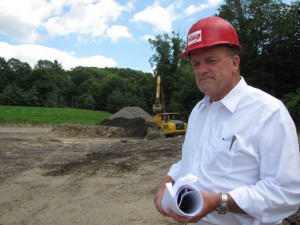13 years and counting

New technology can always be a target for doubt and debate. Charles Babbage, Thomas Edison and the Wright Brothers would probably enjoy seeing how their once “laughable” ideas have become not just laudable, but integral parts of 21st century life.
James Taylor”™s trash-to-energy biomass plant has been 13 years in design, planning and waiting stage. He”™s gotten through all of them, and in the process, has amassed an amazing number of people eager to see his project take off ”“ particularly towns eager to reduce landfill waste and use it for something more productive.
No one is more eager than Taylor, whose grace under fire is admirable, but he readily admits, “It”™s tiring. You get over one hurdle and then there”™s another.”
But patience and determination seem to be ingrained into the man who built a recycling empire from his original tree-cutting service, which he soon put to better use: recycling, which in turn spawned Taylor Recycling nearly two decades ago.
It wasn”™t long after Taylor got his recycling company up and running that his thoughts turned to what trucks were hauling in to be recycled: “What can be done with the garbage we can”™t recycle?” He came up with an answer, worked with engineers, scientists and came up with a design for a gasification plant, one which would take the household trash and turn it into electricity.
Many of Taylor”™s lifelong friends and associates, including James Ottaway, whose newspaper family had been a staple of Orange County for decades, are Taylor”™s angel investors and supporters. He”™s got others, from U.S. Sen. Charles Schumer, Congressman Maurice Hinchey and dozens of state and local elected officials, all who have thrown their support behind the project.
So has the U.S. Department of Energy, which has given Taylor Biomass Energy a $100 million loan guarantee for the project.
“Basically, the proceeds are being issued by the Federal Financing Bank and funds are guaranteed not to be used in any way, shape or form other than on this project,” Taylor said.
A credit subsidy fee on the dollar amount the applicant receives must be contributed to the Department of Energy as insurance collateral in the event of a default on the loan. Taylor”™s credit subsidy fee is in the 15 to 25 percent range of the loan amount. Taylor”™s anticipating having that aspect of the project”™s financing completed by September.
Taylor has never wavered from wanting to build the first gasification plant in Montgomery, although several countries are reaching out for the technology.
Taylor”™s biomass project will use five acres of the 95 the business owns on Neelytown Road in Montgomery. When built, it will expand its current sorting and separating process to accept mixed solid waste in addition to the wood and construction/demolition waste it currently collects.
The Port Authority of New York and New Jersey and the New York Power Authority are already signed up for the “green” credits for the 20 megawatts of power the plant is expected to generate. That works out to an average estimated cost over 20 years of approximately five cents per kilowatt. Those credits are then sold to an independent system operator market the next day. The electricity that will be produced at the biomass plant, said Taylor, is at a rate comparable to supplying power to 23,000 single-family homes.
“What”™s amazing to me,” he said, “is I have people in Santiago and many other countries eager for this technology as a viable solution to end landfills and create electricity. Yes, I”™m anxious to be up and running but patient; I do understand how the system works here. I”™ve already put $20 million of my own money into this project, so I”™m determined to see this through and see my hometown be the first to have it.”
The gasification plant will require 400 construction jobs and create 80 permanent jobs once built. Another aspect of the plant will be the creation of  a new training center.
The promise of educating the next generation to learn to “waste not, want not” is the one Taylor says will train a new generation about the technology. SUNY Orange, Mount St. Mary College, Columbia University”™s Center for Environmental Research and Pace University will all actively collaborate and teach at the center, which will be located at the end of Neelytown Road.
“Once the plant is constructed and goes on line, people who want to bring a gasification plant to their community or country will be able to send a management team here to receive 12 to 16 weeks of hands-on training at the plant,” Taylor said. “Orange County Community College will also offer language courses and business management. Pace will focus on environmental law. Each will bring its own special niche to the center. I can”™t put a number on the jobs that training center will create, but there will be job creation for the next generation of engineers.”
Taylor estimates the total project to be $150 million when completed.
“Yes, it is a lot of money,” admits the soft-spoken Taylor, who”™s got a ready smile, but tired eyes. Yet, not too tired to help fix the copy machine back at the office once the trek to the construction site was completed.